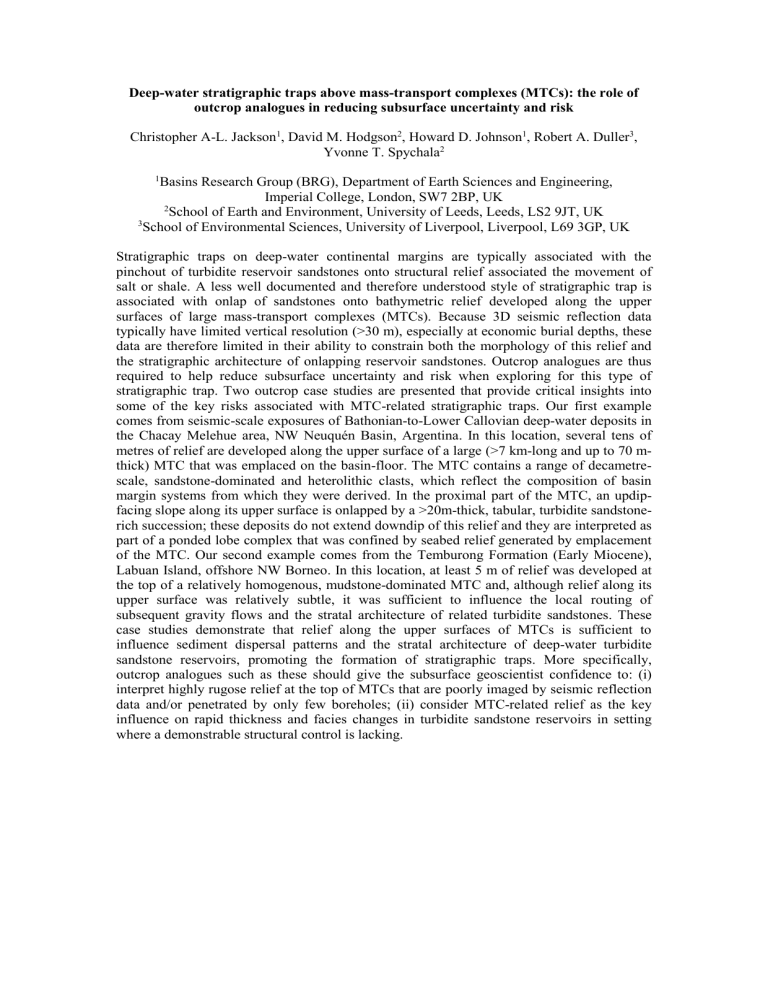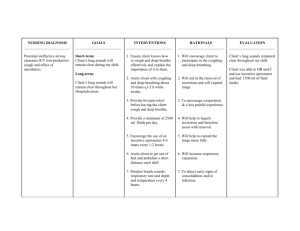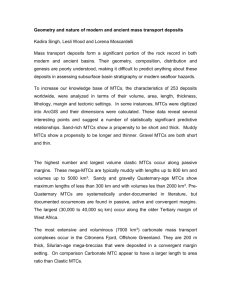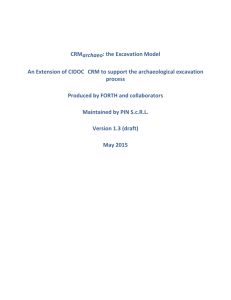Deep-water stratigraphic traps above mass

Deep-water stratigraphic traps above mass-transport complexes (MTCs): the role of outcrop analogues in reducing subsurface uncertainty and risk
Christopher A-L. Jackson 1 , David M. Hodgson 2 , Howard D. Johnson 1 , Robert A. Duller 3 ,
Yvonne T. Spychala 2
1 Basins Research Group (BRG), Department of Earth Sciences and Engineering,
Imperial College, London, SW7 2BP, UK
2 School of Earth and Environment, University of Leeds, Leeds, LS2 9JT, UK
3 School of Environmental Sciences, University of Liverpool, Liverpool, L69 3GP, UK
Stratigraphic traps on deep-water continental margins are typically associated with the pinchout of turbidite reservoir sandstones onto structural relief associated the movement of salt or shale. A less well documented and therefore understood style of stratigraphic trap is associated with onlap of sandstones onto bathymetric relief developed along the upper surfaces of large mass-transport complexes (MTCs). Because 3D seismic reflection data typically have limited vertical resolution (>30 m), especially at economic burial depths, these data are therefore limited in their ability to constrain both the morphology of this relief and the stratigraphic architecture of onlapping reservoir sandstones. Outcrop analogues are thus required to help reduce subsurface uncertainty and risk when exploring for this type of stratigraphic trap. Two outcrop case studies are presented that provide critical insights into some of the key risks associated with MTC-related stratigraphic traps. Our first example comes from seismic-scale exposures of Bathonian-to-Lower Callovian deep-water deposits in the Chacay Melehue area, NW Neuquén Basin, Argentina. In this location, several tens of metres of relief are developed along the upper surface of a large (>7 km-long and up to 70 mthick) MTC that was emplaced on the basin-floor. The MTC contains a range of decametrescale, sandstone-dominated and heterolithic clasts, which reflect the composition of basin margin systems from which they were derived. In the proximal part of the MTC, an updipfacing slope along its upper surface is onlapped by a >20m-thick, tabular, turbidite sandstonerich succession; these deposits do not extend downdip of this relief and they are interpreted as part of a ponded lobe complex that was confined by seabed relief generated by emplacement of the MTC. Our second example comes from the Temburong Formation (Early Miocene),
Labuan Island, offshore NW Borneo. In this location, at least 5 m of relief was developed at the top of a relatively homogenous, mudstone-dominated MTC and, although relief along its upper surface was relatively subtle, it was sufficient to influence the local routing of subsequent gravity flows and the stratal architecture of related turbidite sandstones. These case studies demonstrate that relief along the upper surfaces of MTCs is sufficient to influence sediment dispersal patterns and the stratal architecture of deep-water turbidite sandstone reservoirs, promoting the formation of stratigraphic traps. More specifically, outcrop analogues such as these should give the subsurface geoscientist confidence to: (i) interpret highly rugose relief at the top of MTCs that are poorly imaged by seismic reflection data and/or penetrated by only few boreholes; (ii) consider MTC-related relief as the key influence on rapid thickness and facies changes in turbidite sandstone reservoirs in setting where a demonstrable structural control is lacking.









